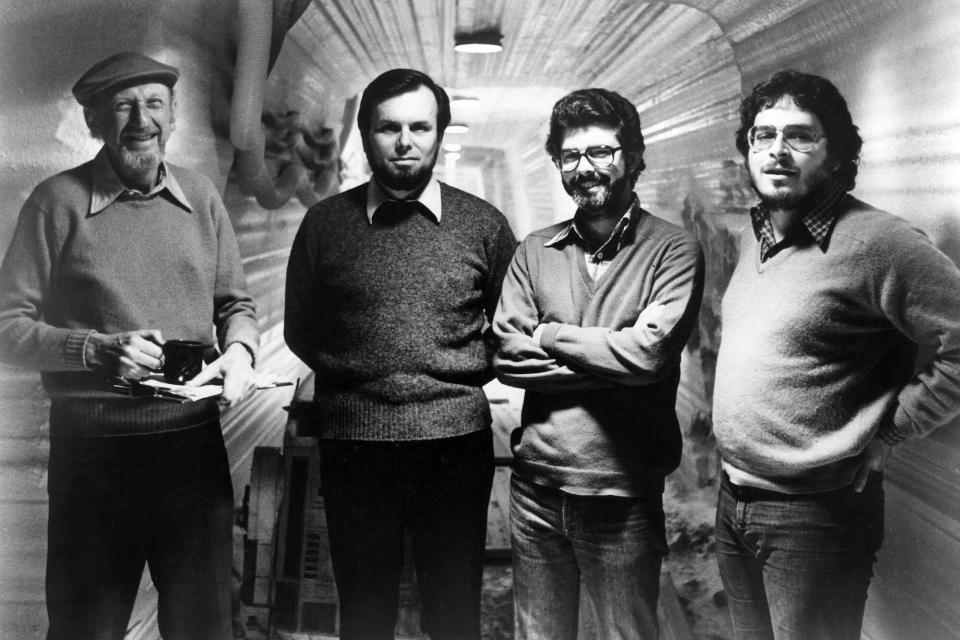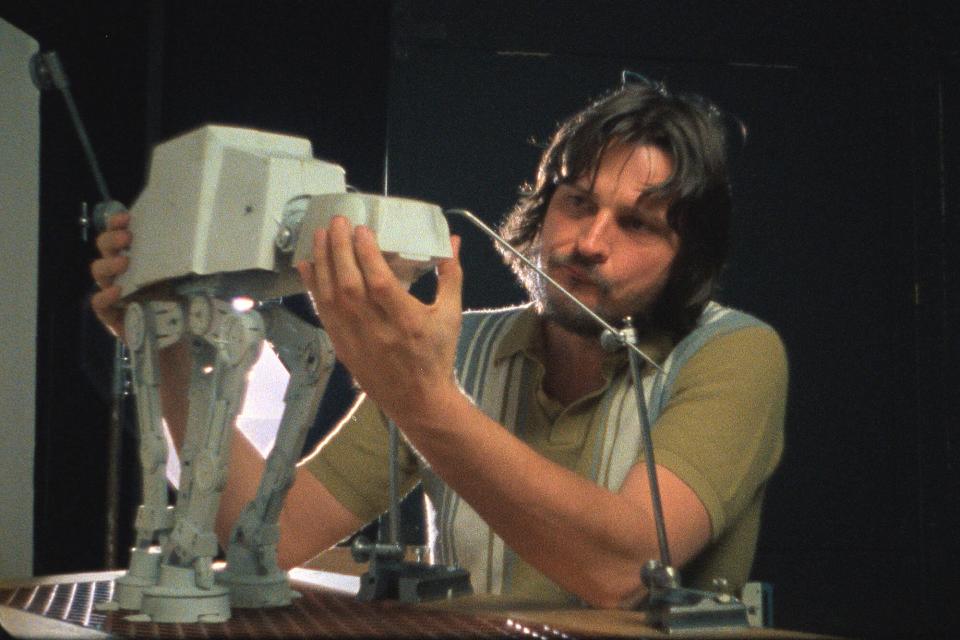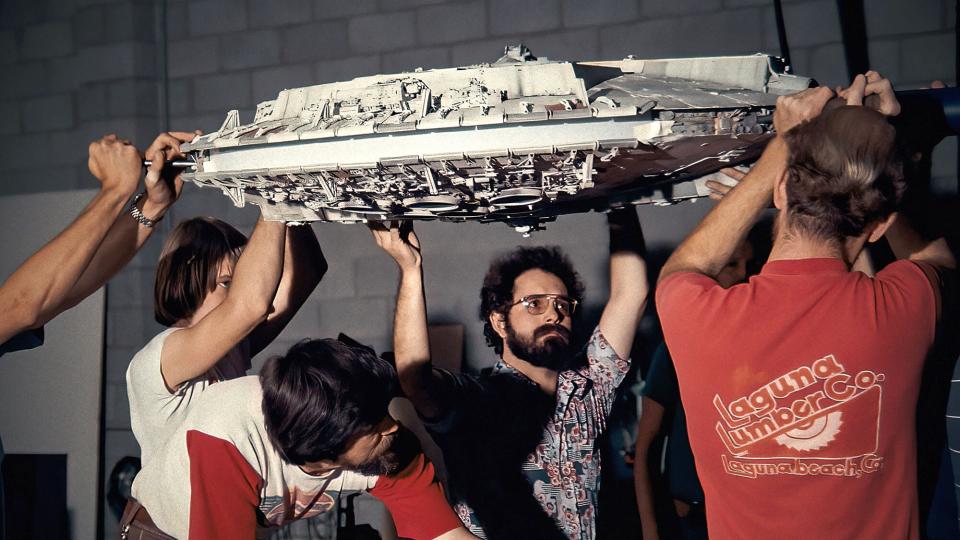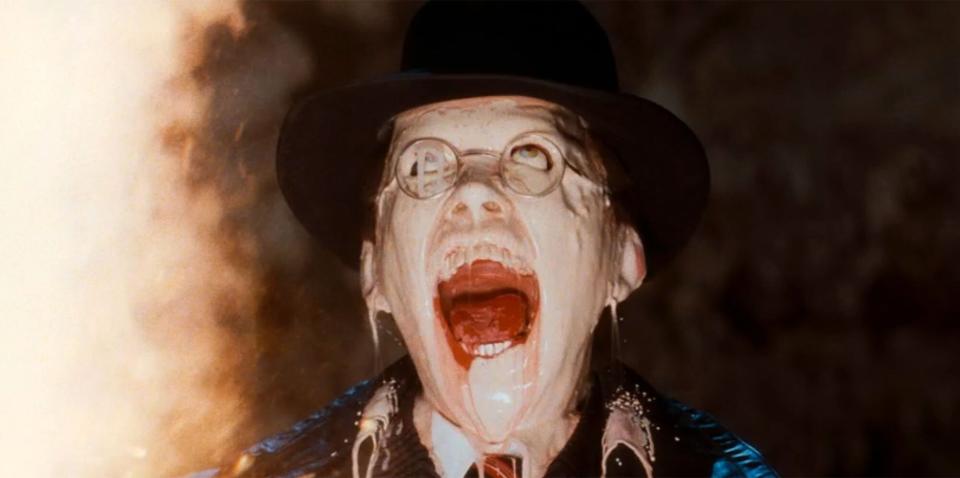Lawrence Kasdan names the best Star Wars special effect ever
- Oops!Something went wrong.Please try again later.
- Oops!Something went wrong.Please try again later.
- Oops!Something went wrong.Please try again later.
- Oops!Something went wrong.Please try again later.
Lawrence Kasdan knows Star Wars. As one of the writers of The Empire Strikes Back, Return of the Jedi, The Force Awakens, and Solo, he's been intricately involved with the franchise for over 40 years. Which is why he wanted to go learn more about the special effects team that brought his words to life in those films and others he worked on like Raiders of the Lost Ark.
The result is Kasdan latest directorial effort, on the new Disney+ series Light & Magic — a six-part documentary on Industrial Light & Magic, the groundbreaking visual effects division of Lucasfilm. Kasdan spoke with EW's weekly Star Wars podcast, Dagobah Dispatch, to talk about his career, why old-school practical effects are cooler than new-school digital ones, his favorite Star Wars special effect ever, melting faces off on Raiders of the Lost Ark, and what he learned while making his new series, which is out now. (You can also listen to the entire conversation, as well as our interviews with Pedro Pascal and a bevy of Star Wars Comic-Con Cosplayers, on the latest episode of Dagobah Dispatch.)

Lucasfilm/Fox/Kobal/REX/Shutterstock Irvin Kershner, Gary Kurtz, George Lucas, and Lawrence Kasdan on set of 'The Empire Strikes Back'
ENTERTAINMENT WEEKLY: Let's go back in time. You're an up-and-coming writer and the first two film jobs you get hired on are The Empire Strikes Back and Raiders of the Lost Ark, two of the greatest movies ever made. What was it like starting your career off that way?
LAWRENE KASDAN: Well, it was kind of amazing. It had taken me seven years to sell two scripts that I had written, two spec scripts. And the second one was purchased by Steven Spielberg. And the day I met Steven Spielberg, he said, "I'm going to do a movie with George Lucas and I want you to meet him. Are you okay with that?" I said, "Yes, I'm very okay with that."
And we walked over and we saw George, and he gave the bare bones of what Raiders would be. And I wrote Raiders before. And when I finished it after about six months, I took it to George and before he read it, he said, "I'm having trouble with the sequel to Star Wars. Will you help me with that?" And I said, "Well, don't you want to read the [Raiders] script first?" And he said, "I'm going to read it tonight. If I don't like it, I'm calling you up tomorrow, I'm taking back this offer." I thought that was perfectly fair, but he did like it. And so I found myself unexpectedly writing first Raiders and then Empire in quick succession. And I was in heaven.
As a writer on those films, how much exposure and awareness did you have at the time with the folks at Industrial Light & Magic who were bringing your scenes to life?
At that time, almost none. And I was busy writing a lot of things, but I visited Empire one time in England. I never was on the set of Raiders. And so I was seeing people do the finished product, and I was amazed. And I was amazed by ideas that I had had and George and Steven had in a little house in Sherman Oaks when we worked it out. And now suddenly it's on screen.
And what I didn't know at that time was who these people were. But over the years, I've used them. I've made other movies there. And I saw that the group was a group of geniuses and I loved the spirit that they had with each other. And it continued right through the generations.
And you can see there's a real affection in these people for each other, for their experience. They're very grateful for having the experience of working there, being around these equally brilliant people. So I found that all kind of moving. And as the years went by, I got to see and know more about them. And then, of course, this was the deep dive that I just really wanted to take. Where did these people come from? How did they wind up at ILM?

Lucasfilm Ltd. An AT-AT from 'Light & Magic'
When I watch the episodes looking at the early years of ILM and I see all these practical, what would now be considered primitive effects with the models, and stop-motion, and matte paintings, there is a fondness and often a preference I have towards some of those practical effects over the much smoother CGI that we see today. Is that just my childhood nostalgia speaking or is there something special and magical about that old-school method of doing things?
There is. And I don't think that's a nostalgia at all. Many things in our world and our culture have gone from being handmade with their fingers, with their hands, with their eyes, modeling things, painting things. They've gone from that tactile place into a digital place. And sometimes the digital stuff is brilliant, but it can't have that thing. And I think what you're talking about is an affection. It's not just you. It's the species. They did it before anything. They were in caves and making things, they were painting on the walls. I think there's something irresistible about that. And when you don't see the tactile part of it, you miss it.
I think part of it is also the: How did they do that? Stuff looks amazing now, like you're saying, but we kind of know that they're just doing it on a computer. When I watched those old movies it was: How did they do the Tauntaun? How did they do these things? That's the magic for me.
Well, that's what I wanted to show to be about. And not only how did they do it? Because the patience and the art involved is astounding. But also how did they feel about it? I wanted to know what kind of person can do what Phil Tippett does with that Tauntaun hour after hour, moving the Tauntaun a fraction of an inch and then climbing on his stomach under the set and going to the other Tauntaun. It's just astounding, the patience and the dedication that they brought to all of those undertakings.
Now there are people sitting at computers doing digital stuff and it's painstaking work. But for people who've been around a little while, you miss that feeling of like, "Oh, where's the room where they did this?"

Lucasfilm Ltd. Joe Johnston, John Dykstra, and Dave Jones in 'Light & Magic'
What is a favorite effect of yours from a Star Wars film that still gives you chills or just visually just knocks your socks off? As you were going through and looking at all this stuff over again, to make your series, what's the one that really impresses you the most — either with the work it took them to get it done, or just the way it looks on the screen?
There are millions, but I have to go back to A New Hope, because that was what blew my mind and everybody in the theater around me in 1977. And so many of these people that worked at ILM subsequently, they were seeing that movie around the world and saying, "How'd they do that? Why is it more exciting than anything I've ever seen?"
They know that there have been spaceships in movies since the beginning. Why is this so dynamic? Why is it so fast? Why is it so energetic? And so everything that's in A New Hope is the seed for everything that follows. And they found out different, better ways to do it, but nothing can equal. That's like being there when Thomas Edison invented the light bulb.
It's that first shot too, right? Underneath the Star Destroyer, when it goes across your screen, you're like, "What is happening?"
Yes. And I love it. It's in the show that you see how they were thinking and how [Richard] Edlund was figuring it out. And what did it look like when they first tried it? It's so simple. And like you, that's my favorite effect ever.
When I was a kid, there's a scene in Raiders of the Lost Ark that literally gave me nightmares. I'm guessing you know what scene it is, don't you?
Tell me.
It's the face melting scene, which you guys get into in this series. What was it like for you to see that scene come to life… or death, I guess, as it were?
It was amazing that they had figured out such a good way to do it. And Steven will be the first one to tell you that. And he says it in the show, I think. I didn't know what to do, but I went to them and said, "How can we do this?"
And that's really the story of ILM, because these images don't come full blown from people. They come as an idea, and they're dependent on the people at ILM to make it real. And that happened with that very tactile... It's a wax figure melting under the heat. That's very powerful. When people say to me, "What do you think about the evolution of effects?" I think, "Well, it didn't get any better than that," that one moment when the head melts. Because everything else, as we go along, you think they can do anything. But when that movie came out, you didn't think that. You thought, "What just happened?"

Lucasfilm Ltd. Face-melting from 'Raiders of the Lost Ark'
You've had a lot of experience working with this company over the years, but you went in deep to research it for this series. What's the most interesting thing you learned about ILM while making this series?
Well, there was something that I hoped, I didn't know it, but I was hoping. It seemed to me being on the outside of it and being around it for so long that this community that makes up ILM — and now it encompasses people my age to people who are very young — that community has been infused with the kind of generosity toward each other. It's a team sport. And I suspected that. I hoped that.
I wanted to know if you go back to the original people and follow that story up to the present day, what will you see? And what I saw is people who got an idea in their head, very young, what they wanted to do, and then found themselves in the perfect place to do those things. So it's astounding to see a 10-year-old Ken Ralston making a movie. And he winds up here, where 50 years later, that's what he did with his life.
Speaking of the people, I know, being a reporter, that it's difficult sometimes when you're asking people to recall things from decades ago. And sometimes you ask two different people about something, you get two different sometimes contradictory stories. So what was it like talking to the creative types, like a Phil Tippett or Dennis Muren, to get their memories about big events and effects and things of that nature?
Well, that was my main goal. I would prep for each interview. So I knew a lot about that person and who were there at the same time, who was there with them, who were their friends at that time, who did they now consider a friend 40 years later. That's kind of amazing that they could work together and do hard work for so long and really feel that this is a friendship that will last forever. I love that feeling, generosity of affection between them. And I sort of hope that would be what it was. And it turned out to be much more than that.
It looks like they were pretty great about documenting things with behind-the-scenes footage and photos when they were making these early films like Star Wars, Empire, and Raiders. What was it like going through that archival stuff?
I had a great producing group from Imagine, and the freelance producers that came on and the research people and the archivists. They're astounding, and like you say, Lucasfilm is probably the most well documented enterprise like this ever because George Lucas decided when he was making A New Hope that he wanted a good record. When he was making American Graffiti, he wanted there to be a record of the process. And he with full commitment, always had people documenting it. And we had access to things that no one's seen. And that's kind of thrilling when you see.
I love it when they're talking about an effect and then you see when the effect was first drawn and how it changed. And I find that amazing. I find these people amazing. And Phil Tippett says, "Yeah, they said they wanted this kind of creature. So I sat down and did a few of these things in an hour." And you see these incredible drawings, any which one could have become the Tauntaun. And you should say, "Wow." If I spent my whole life, I could never draw a picture that way.
Listen to the full conversation with Lawrence Kasdan as well as our interviews with Pedro Pascal and Comic-Con cosplayers on EW's new Star Wars podcast, Dagobah Dispatch.
Want more movie news? Sign up for Entertainment Weekly's free newsletter to get the latest trailers, celebrity interviews, film reviews, and more.
Related content:

